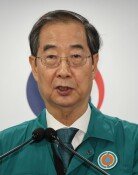Liberals` damage to `innovation schools`
Liberals` damage to `innovation schools`
Posted December. 01, 2012 06:53,
The policy that the left-leaning superintendents of five metropolitan cities and provinces nationwide have focused on the most is innovation schools. Kim Sang-gon, head of the Gyeonggi Provincial Office of Education, adopted the slogan, I will transform all schools into innovation schools. Kwak Noh-hyun, who just lost his post as superintendent of the Seoul Metropolitan Office of Education after being convicted of bribery in his election, also formed 50 innovation schools, including 29 elementary, 20 middle and 10 high schools. The country has 354 such schools nationwide, which are called the flagship brand that symbolizes the education policy of progressive forces.
The recently released results of the 2012 academic performance evaluation suggested that innovation schools performed at a meager 30 percent of the level that other schools in the same regions achieved in grades improvement. Assuming that other schools saw a double-digit rise in test scores, this means innovation schools saw an improvement of just three. In certain cases, the latter even saw scholastic performance deteriorate. The average level of academic improvement in high-school level Korean suggested that innovation schools saw their level drop 0.64 of a percentage point, while the average in other cities and provinces edged up 0.07 of a percentage point.
Innovation schools have received 100 million won (92,000 U.S. dollars) in annual subsides each from education offices, and enjoys a teacher-to-student ratio of 25. The average number of students at an ordinary elementary school in Gyeonggi Province is about 30. The reality is that despite gains in school budget and reduction of teacher workload, academic performance has effectively slumped at innovation schools.
Many innovation schools do not require students to take a mid-term exam. Certain parents said students merely chat all day long at school in the name of debate-focused classes, and come home empty-handed. Because of no tests, students grow lazy and too easygoing in class. The portion of teachers affiliated with the progressive Korea Teachers and Education Workers Union at innovation schools accounted for 24.4 percent last year, nearly double the national average of 12.3 percent. At 24 innovation schools, the number of teachers belonging to the union exceeded half of each school`s total. So the slumping academic performance at innovation schools is a testament to the limits of the education style pursued by the liberal teachers union and spearheaded by leftist superintendents. Parents could think that innovation schools provides quality education and beat other schools in non-academic fields as well. Leftist superintendents should stop misguiding and seducing students and parents with the slogan innovation, and instead warn them that academic performance at innovation schools could deteriorate.
Under an egalitarian school system, parents have no authority to opt for and reject innovation schools for their children. Elementary and middle school students are assigned to schools according to their home addresses. The random selection method is also used to assign students to high schools. If parents know how bad the academic performance is at such schools, they would not want to send their children there. Education consumers should have the right to choose schools and reject random assignment of students to innovation schools. Perhaps one day, the left-leaning education superintendents will hopefully reflect on their exploitation of students as a subject for their experiments with ideological education.







